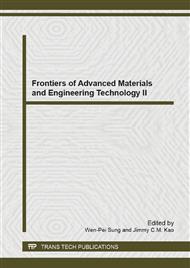p.263
p.269
p.273
p.277
p.281
p.285
p.288
p.293
p.297
Preparation of Platinum Catalyst Supported on Porous Carbon Nanofibers
Abstract:
Low-temperature fuel cells have been attracting more and more attentions for the direct conversion of chemical energy into electricity. Efficiencies of fuel cells to a great extent depend on the activity of the catalytic platinum and its alloys. Increasing the reaction surface area and decreasing the diameter of platinum particles can enhance the activity of the platinum. In this paper, we report a platinum catalyst supported on porous carbon nanofibers. Two kinds of PAN terpolymers with various molecular weights of 15 kDa (PAN-1) and 30 kDa (PAN-2) were first prepared by aqueous precipitation polymerization. The mixtures of PAN with various molecular weights and PMMA were then electrospun, stabilized and carbonized to provide the porous carbon nanofibers. It was found that the PAN with lower molecular weight results in the even fibrous surface and thick diameter, indicating a stable spinning process. Moreover, the PAN-based carbon nanofibers were immersed into a platinum complex solution to support the platinum positive ions. After calcination, the platinum ions deposited on the carbon nanofibers were converted into nanoplatinum particles to provide the platinum catalyst supported on the porous carbon nanofibers.
Info:
Periodical:
Pages:
281-284
Citation:
Online since:
April 2014
Authors:
Keywords:
Price:
Сopyright:
© 2014 Trans Tech Publications Ltd. All Rights Reserved
Share:
Citation:


